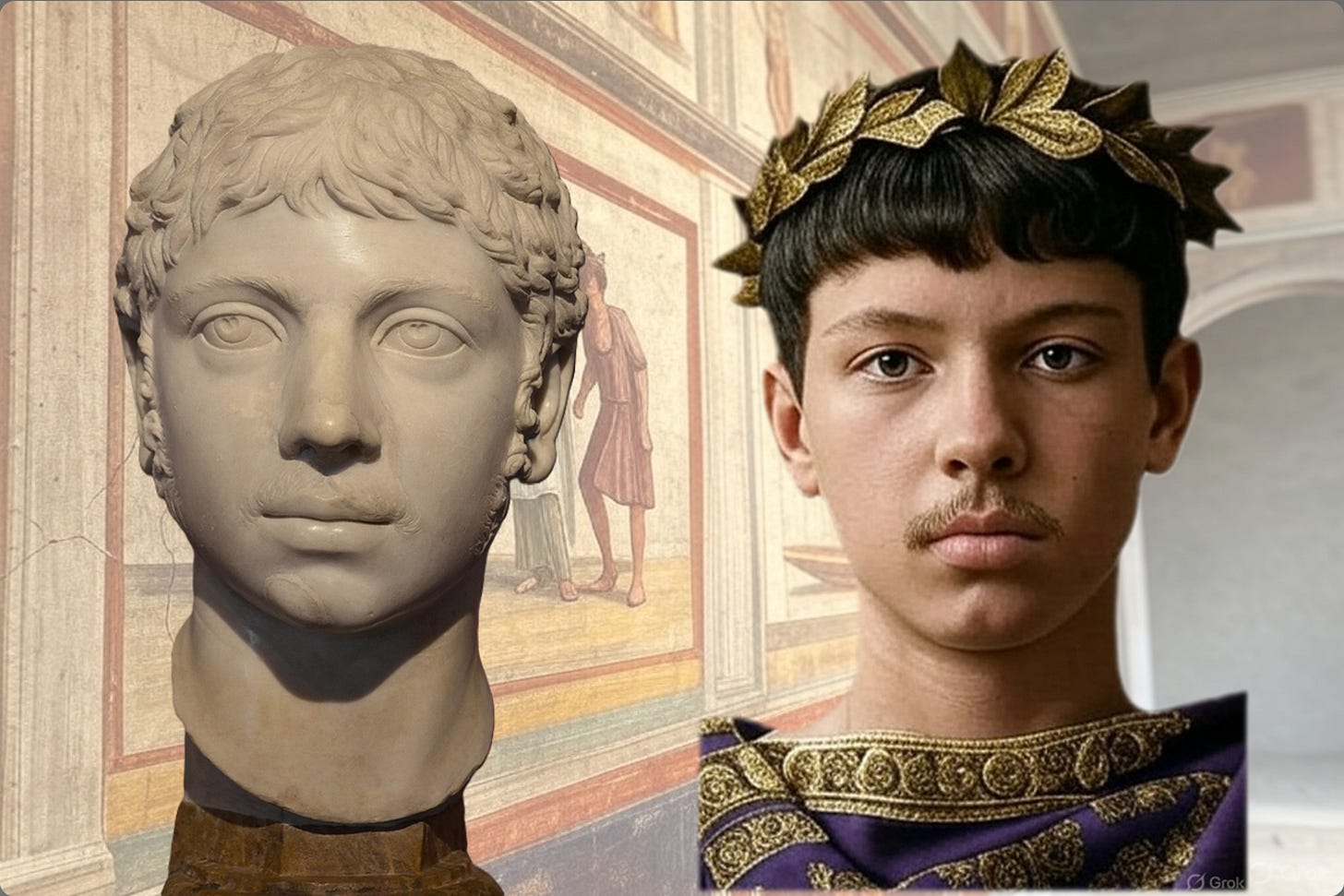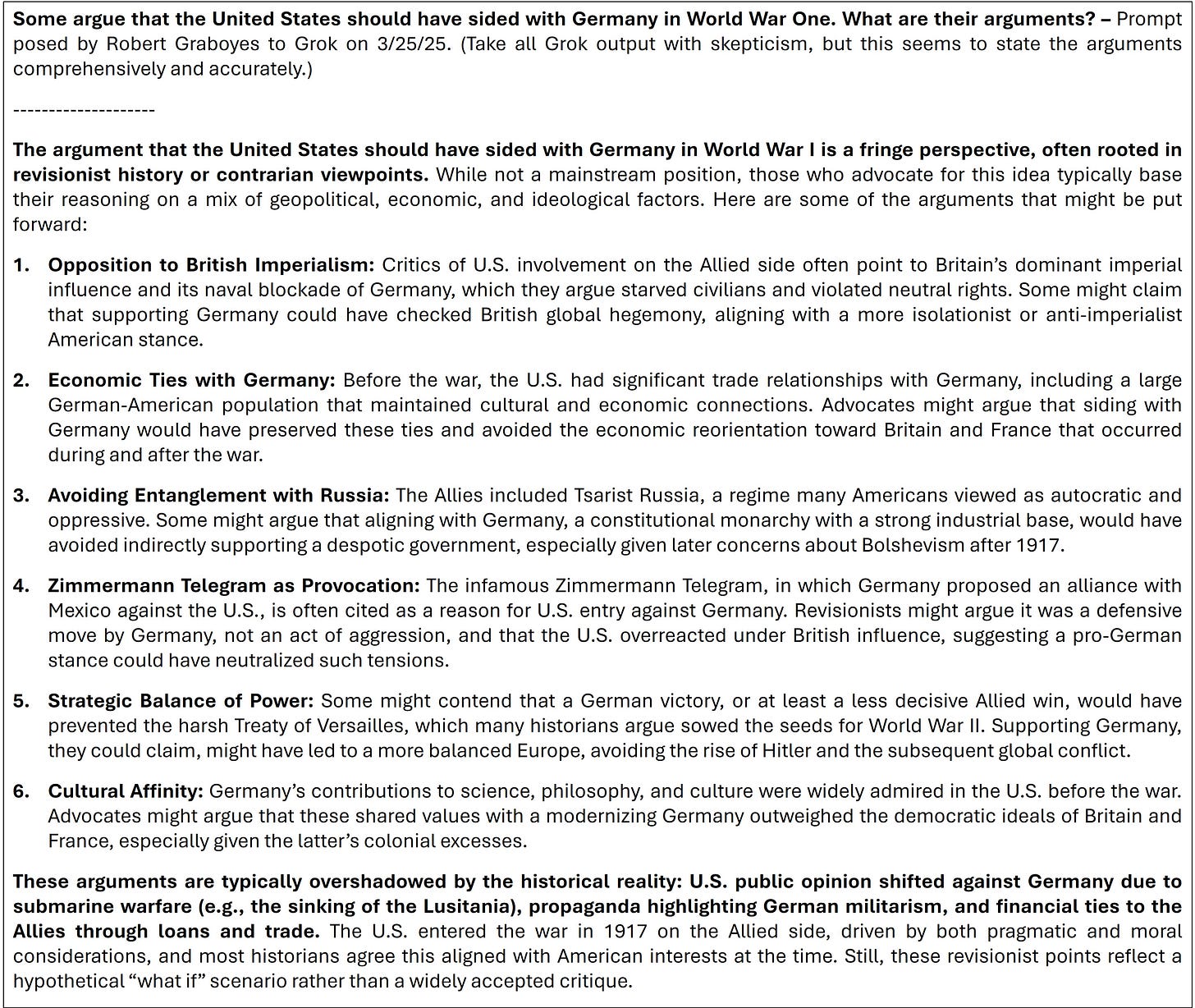Elagabalus, Sleezebiscuit, Suthichai, Hohenzollern, and Joe
A platter of artificially intelligent amuse-bouches and thoughts on how AI will change the classrooms, workplaces, and courts of law

My artificial intelligence bender continues today—trying to get a grasp on what may be the biggest communications game-changer since Gutenberg. For over two years, I’ve exchanged thoughts with Joe, a former university colleague, about how AI will impact the classroom. After showing you a few of my recent AI interactions, I’ll offer thoughts on AI might change what writers do and how readers will evaluate them. Framed in terms of student and professor, the principles are applicable to workplaces, courts of law, etc.
[1] ELAGABALUS
Asking classicist Mary Beard to compare contemporary politicians to Roman emperors seems to annoy her. In December, she explained how she handles her most frequent query:
“[T]he commonest Roman question put to me is: ‘Which emperor is Donald Trump most like?’ The true answer is ‘none.’ But I now tend to reply ‘Elagabalus,’ a little-known, unbridled teenager on the throne in the early third century. It’s not because I think Trump really is like Elagabalus, but because I suspect that this emperor will be a new one on the questioner, so they’ll at least have to go away and look him up.”
Thus, Beard disposes of such questioners by shuffling them off on a MacGuffin quest—a snipe hunt.
Ms. Beard’s stratagem worked with me. Before going farther in her article, I opened another window and searched for Elagabalus. Bastiat’s Window is a family publication, so we won’t go into the darker corners of the emperor’s bio, but here are a few superficial details. He ruled as Marcus Aurelius Antoninus, “Elagabalus” being a posthumous name. His grandmother persuaded the Army to place him on the throne at age 14, and the Praetorian Guard killed him and his mother when he was 18. His reign was remembered for religious controversy and sexual debauchery. His name became a Spanish word for gluttony—“heliogábalo.”
Imagining his depravities as I read all of this was impeded by the fact that my mind’s eye was picturing him as a marble bust. Having just brought thirty historical figures back from the dead via AI (“I See Dead People” part 1 and part 2), I decided to summon forth one more. The boy-emperor’s marble bust turned to flesh-and-flood; both images appear side-by-side atop this essay. Now, I see him more as Romans did—a scowling little creep with a teenage mustache. THIS is the guy the Praetorian Guards killed—not some marble statue.
[2] SLEEZEBISCUIT
I asked Grok, “Who is Alanna Graboyes?” and it blurted out a comprehensive, accurate 177-word bio describing her artwork, the book she wrote, our marriage, and her frequent mention in Bastiat’s Window. Then I asked, “What is Bastiat’s Window?” The response showed AI’s best and worst characteristics. I’ve marked the worst in red:
Mostly accurate and insightful, but bearing four small errors and one huge one. First, the peccadillos: [1] I left Mercatus in 2022. [2] Bastiat’s Window launched in 2022, not 2020. [3] I’ve discussed fiction, but never published it. [4] There are paid subscribers, but no paid content. Then the mortal sin: [5] In the second sentence of the second paragraph, Grok apparently smoked ayahuasca and went on a psychadelic vision quest. Bastiat’s Window has never offered “Friday Night Videos” or “Poetic License.” We’ve never written of “Burton van Sleezebiscuit,” and a Google search suggests no one else in human history ever has. I did discover that there was a recurring character called “Maestro Gunter van Sleezebiscuit” on adult cartoon American Dad! (a show I’ve never seen). This train wreck of a sentence is pretty funny, unless you’re the attorney who used ChatGPT in 2023 to write a legal brief, only to hear from the judge that the citations were believable-sounding, but nonexistent “hallucinations.”
Grok (like many other AI platforms) doesn’t like to own up to shortcomings in its knowledge. If it doesn’t know something, it gives you bullshit—like some high-schooler who didn’t do his homework and hopes the teacher won’t check his facts. For instance, the app can produce remarkably good images of most U.S. presidents, but, oddly, it has no idea what Zachary Taylor, Franklin Pierce, Rutherford Hayes, James Garfield, or Chester Arthur looked like. I asked for all five, and here’s they are. Notably, Chet Arthur has become the first African American president—a stunning achievement for 1881.

[3] SUTHICHAI
While watching TV, Alanna and I often have questions about characters and plots. AI platforms such as Grok hoover up info to quickly give remarkably detailed answers to highly specific questions. Here are two examples:
We just watched The Residence, a delightful, tongue-in-cheek Agatha Christie-style murder mystery set in the White House. Miraculously (for 2025), the producers avoid any hint of politics. The president, his husband, their extended families, and their political advisors are all buffoons, with no indication of party. The Secret Service, FBI, Metropolitan Police, and National Park Service battle childishly over turf while a super-detective ridicules them all. Most of the action involves organizational intricacies of the residential staff—butlers, cooks, plumbers, ushers—and mostly in the unseen parts of the White House (kitchens, hallways, bedrooms, utility rooms, garden sheds). The architectural details are dazzling and often surprising. So, I asked Grok, “How accurate is the White House portrayal in The Residence?” A second later, out rolled an 897-word discourse that began with:
I’d never heard of the book and, hence, had no idea of its role in inspiring the TV series. So far as I can tell, Grok brilliantly summarized both. In closing, it offered that, given the date (five days after the episodes dropped), I was probably asking about the series, but thought the info on the book would be useful. If you care to read the “essay,” here it is—with no spoilers:
The most recent episode of The White Lotus featured the head of a Thai Buddhist monastery, and I wondered whether he was a genuine monk. (In 1993, Bernardo Bertolucci used actual monks in his Little Buddha.) Grok told me that the monasteries were authentic, but it was unfamiliar with the character I mentioned. A day or two later, I asked again, and this time it said:
Fact-checking confirms the info on Suthichai. AI learns quickly. My guess is that it scours online discussions and comments as well as formal articles.
[4] HOHENZOLLERN
A fellow Substack blogger recently expressed surprise upon learning how enormously unpopular World War One was in hindsight. In an email, I told him that a small number of historians argue that America would have been better off siding with Germany. Had Germany won, they argue, its ruling Hohenzollern Dynasty would have remained on the throne—avoiding the post-Versailles vacuum into which Communists, Nazis, naïve Socialists, hardline religious groups, anarchists, and nihilists rushed. I wanted to provide some additional background but didn’t feel like sending him a weighty citation or bibliography or spending an hour organizing the arguments. So, I simply asked Grok:
“Some argue that the United States should have sided with Germany in World War One. What are their arguments?”
It instantly handed me a 477-word answer:
I haven’t fact-checked this, but I know the history pretty well and don’t see any hallucinations or other errors.
[5] JOE
Joe is a legendary professor, and ever since ChatGPT appeared, he and I have discussed whether students should be allowed to use AI in writing assignments and, if so, under what conditions. As of today, I’m convinced that it will be impossible to prevent students from using AI in their writing and that it’s counterproductive to even try. Instead, the challenge for professors will be to help students harness this capability. By analogy, in the early 1970s, I could do square roots by hand. Today, (1) I just punch =SQRT(X) into Excel; (2) I couldn’t do a square root by hand if my life depended upon it; and (3) Neither I nor the world is worse off because I’ve lost that tedious, time-consuming skill.
At the university where Joe and I taught, I gave my students writing assignments. Students were uniformly bright, with SATs hovering just below Harvard’s. But 90% of them handed in prose that read as if they were suffering neurological disruptions. I eventually stopped assigning papers, because reading them was bottomless torture. [NOTE: If you were one of my students back then, YOUR writing was fantastic. I’m only talking about your classmates. :)]
Going forward, I expect students to write most of their essays with the assistance of AI—and I‘m getting comfortable with that. I imagine an A paper will differ from a B, C, D, or F paper because the student:
Devises more interesting, better-crafted questions than his or her classmates.
Repeatedly reads the output and then revises prompts to produce even better output.
Builds a longer paper from multiple prompts that fit together as snugly and logically as a jigsaw puzzle.
Carefully fact-checks the veracity of statements made in the paper.
Authenticates all the citations appearing and assures that they are relevant to the paper. [ADDENDUM (3/31/25): And provides readers with easy confirmation of said authentication.]
Revises the prose to make it more compelling, entertaining, elucidating.
Successfully explains and defends the paper under rigorous oral questioning.
I don’t pretend that the transition to this new reality will be easy for professors or for students. I’m confident that the same transition will occur in workplaces as well as in schools. And that lawyers WILL use AI to write their briefs.
HAIL, EMPEROR BOB!
Like the five presidents discussed above, my face is unknown to Grok, so ask for me, and you’ll get a glamour shot of Mr. Generic. However, I learned this week that the app has a feature that allows you to upload a photo and then ask the app to manipulate that photo. Since we began this post with a Roman emperor, let’s conclude that way. In the sequence below, the leftmost image is a 7- or 8-year old headshot of me. I asked Grok to convert that photo into three images of the Emperor Bob—in marble, in the flesh, and in fresco. Not perfect, but I wasn’t all that well-known to Ancient Roman sculptors, photographers, and painters. (I could have told Grok to remove the eyeglasses, but I like anachronisms.)
(As this piece goes to press, social media are all aflutter with a new photo-manipulation platform from OpenAI.)










With your permission, I’m going to start a band and name it “Burton Van Sleezebiscuit”.
Germany's war aim in the First World War was the same as in the Second. They wanted a German-ruled empire from the North Sea to the Ural Mountains. They came close for a moment, when the Treaty of Brest-Litovsk ceded a swath of territory to them from the Crimean Peninsula to Estonia. German victory would have meant even more territorial concessions in Western Europe and would have given Kaiser Wilhelm a chance to make Germany an international naval power. The end of the war would not have been the disastrous Treaty of Versailles, it would have been a disastrous Munich Conference.